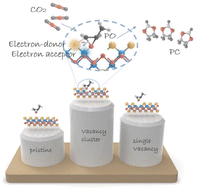Vacancy-cluster-mediated surface activation for boosting CO2 chemical fixation†
Abstract
The cycloaddition of CO2 with epoxides towards cyclic carbonates provides a promising pathway for CO2 utilization. Given the crucial role of epoxide ring opening in determining the reaction rate, designing catalysts with rich active sites for boosting epoxide adsorption and C–O bond cleavage is necessary for gaining efficient cyclic carbonate generation. Herein, by taking two-dimensional FeOCl as a model, we propose the construction of electron-donor and -acceptor units within a confined region via vacancy-cluster engineering to boost epoxide ring opening. By combing theoretical simulations and in situ diffuse reflectance infrared Fourier-transform spectroscopy, we show that the introduction of Fe–Cl vacancy clusters can activate the inert halogen-terminated surface and provide reactive sites containing electron-donor and -acceptor units, leading to strengthened epoxide adsorption and promoted C–O bond cleavage. Benefiting from these, FeOCl nanosheets with Fe–Cl vacancy clusters exhibit enhanced cyclic carbonate generation from CO2 cycloaddition with epoxides.

- This article is part of the themed collection: 2023 Chemical Science HOT Article Collection


 Please wait while we load your content...
Please wait while we load your content...